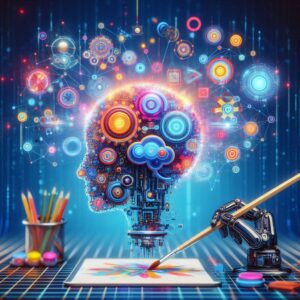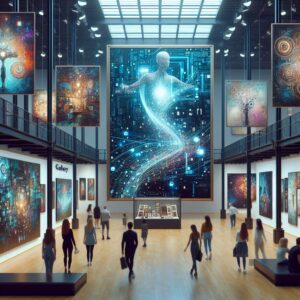The creative industries are undergoing a sea change due to the power of generative AI, often known as creative AI. This technology has the potential to generate original works of art, songs, fashion designs, and screenplays. It changes how artists, musicians, designers, and filmmakers create by providing them with new resources and methods to enhance their creativity.
The visual arts are among the many fields touched by generative AI. Algorithms and AI have allowed artists to produce unique and stunning pieces. This technology allows artists to try out new styles and approaches previously unheard of. Also, generative AI may help artists by suggesting ideas and inspiration they hadn’t considered before.
Generative AI has also found a home in the music composition sector. These days, the algorithmic composition of melodies, harmonies, and whole songs is within the reach of every musician. Technological advancements allow artists to experiment with different sounds and styles. As a bonus, it has lowered the barrier to entry for those who want to compose music but lack a background in music theory.
Key Takeaways
- Generative AI is emerging as a powerful tool in creative industries.
- Understanding the basics and benefits of generative AI is crucial for its practical use.
- Generative AI revolutionises artistic expression, music composition, fashion design, and film production.
- Generative AI also impacts advertising and marketing and can potentially transform the future of creative industries.
- Addressing concerns around stability and ethics is essential for the responsible use of generative AI in creative industries.
Understanding Generative AI: The Basics and Benefits
Machine learning and algorithmic methodologies are used in generative AI to generate new content. Generative AI, in contrast to other forms of AI, is concerned with producing original content rather than just analysing and interpreting existing data. Data inputs and algorithms are used to create something fresh and original.
Implementing generative AI will benefit the creative industries greatly. Above all else, it will provide creative types, including musicians, designers, and filmmakers, with additional resources to enhance their work. It will also give them the chance to try out different approaches and ideas, which will help them grow professionally.
Open invention is a potential outcome of generative AI. It removes barriers to creativity and expression by making technology accessible to everyone, regardless of their educational or occupational experience. This opens up new possibilities for those who lacked the financial wherewithal to enter the creative industries in the past.
The Power of Generative AI in Artistic Expression
The influence of generational AI on creative expression is substantial. Algorithms and machine learning have opened up new possibilities for artists, allowing them to produce visually stunning and unique pieces. This technology allows artists to try out new styles and approaches previously unheard of.
Artworks by Mario Klingemann, a German artist well-known for using machine learning algorithms, demonstrate the use of generative AI. Klingemann challenges traditional ideas of beauty and aesthetics through generative AI to create abstract, one-of-a-kind artworks. He has received critical praise for his work, which has been shown in galleries worldwide.
Generative AI is likewise shaping the way we conceptualise art. Creativity has long been considered an attribute unique to humans, and artists have long been associated with this idea. However, generative AI shows that computers can think creatively, casting doubt on this idea. These profound questions call into question the very definition of creativity and artistic expression.
How Generative AI is Revolutionizing Music Composition
The use of generative AI has revolutionised the way music is created. These days, the algorithmic composition of melodies, harmonies, and whole songs is within the reach of every musician. Technological advancements allow artists to experiment with different sounds and styles.
One American composer and musician who has found success using generative AI in her work is Holly Herndon. Generative AI is more than just a tool for Herndon; it’s a creative force that propels her to create groundbreaking electronic music. She is a pioneer in artificial intelligence (AI) generative music, which she uses to create elaborate and captivating soundscapes using her voice.
Generative AI is transforming the concept of music itself. Making music has always been thought of as an art form that requires a great deal of precision and expertise. But generative AI debunked this idea, showing that everyone with a computer can create music. This opens up new possibilities for those who would benefit from more extensive instruction in music theory.
The Role of Generative AI in Fashion Design and Textile Production
The fashion industry is also using generative AI to revolutionise textile production and design. Designers can now use algorithms to generate fresh, unique clothing designs. With this technology, designers may push the limits of traditional fashion by experimenting with new shapes, colours, and materials.
A Dutch fashion designer who is well-known for her tech-driven designs is Iris van Herpen; she works with generative AI. To create her intricate and cutting-edge fashion designs, Van Herpen uses generative AI algorithms. Her work has received acclaim from all around the world and has been seen at prestigious fashion events.
Our view of style is evolving as a result of generative AI. Fashion design was once thought of as a niche profession. This idea, however, is being challenged by generative AI, which shows that anybody with access to technology may come up with original and creative clothing designs. This helps to level the playing field in the fashion industry and encourages innovation by providing new opportunities for those without degrees in the subject.
Exploring the Potential of Generative AI in Film and Video Production
Generative AI enhances the creative process in film and video creation. Algorithms are now tools for screenwriters, storyboard artists, and visual effects designers. With this technology, filmmakers may try out new approaches, breaking free from the limitations of conventional filmmaking.
Oscar Sharp, a British filmmaker, exemplifies how generative AI may stimulate original thought. He uses generative AI to write and draw storyboards for his films, which use machine learning algorithms. But that’s not all he does. By combining these AI-generated assets with his ideas and vision, Sharp can create unique and captivating films that captivate and amaze viewers.
When it comes to making movies and videos, generative AI is changing everything. Making films has always been considered a very technical and skill-based profession. However, generative AI disproves this notion by showing that anybody with the right tools can create compelling films. People without access to conventional filmmaking training now have more opportunities than before.
The Impact of Generative AI on Advertising and Marketing
The advertising and marketing industries also use generative AI to create unique and tailored campaigns. Algorithms allow businesses to design personalised advertisements and promotional materials. This software allows companies to target customers with personalised messages, increasing the effectiveness of their campaigns.
One company that employs generative AI in its marketing campaigns is Coca-Cola. The business uses generative AI algorithms to create unique bottle labels. Customers’ names and hobbies were among the information used to personalise the labels. With so much buzz and engagement on social media, our campaign was a smashing success.
We are rethinking marketing and advertising because of generative AI. There was a time when people thought advertising and marketing required much imagination and planning. Nevertheless, generative AI casts doubt on this notion by showing that computers may exhibit creative and strategic thinking. This makes one wonder how crucial human imagination is to the advertising and marketing industries.

The Future of Creative Industries with Generative AI
Generative AI in the creative sectors bodes well for their future. As technology progresses, we can anticipate increasingly innovative uses of generative AI across a wide range of creative industries.
There is much promise that generative AI will revolutionise the fields of architecture and design. Architects might use generative AI algorithms to make unique, eco-friendly, and sustainable building designs and designers to create unique, comfortable furniture.
Another area where generative AI shows promise is literature and writing. For instance, generative AI algorithms might help writers develop narrative ideas, create character profiles, and even write full books. This technology has the potential to be a great asset to authors, helping them with editing, rewriting, and providing new recommendations and ideas.
Addressing Concerns: Stability and Ethics of Generative AI in Creative Industries
Generative AI has many potential benefits, but others are worried about its reliability and the moral consequences it may have. Generative AI algorithms’ stability is a matter of concern. The enormous datasets used to train these algorithms increase the risk that they may generate biased or insulting results. The arts and society at large may feel the effects of this negatively.
The use of generative AI in the creative industries raises additional ethical concerns. The question of who owns the works created by generative AI is open. Furthermore, problems are present regarding the impact of generative AI on creative sector job chances. There is a real risk that human creativity will be undervalued as robots become more capable of creating creative stuff.
Thorough management and oversight can alleviate these worries. Legislators, business executives, and creative specialists need to collaborate to define the best ways to use generative AI in the creative industries. This method, when implemented, will promote creativity and innovation while ensuring the ethical and responsible use of generative AI.
Embracing the Power of Generative AI for Enhanced Creativity
Generative AI is giving artists, musicians, designers, filmmakers, and marketers new tools and ways to enhance their creativity, causing a revolution in the creative sectors. It completely changes how we see and understand advertisements, music, fashion, and entertainment.
Extensive control and supervision can ease concerns about the stability and ethical consequences of generative AI. Artists and other creatives must not only see the promise in generative AI but also use it with integrity, making sure it improves their work without lowering their moral standards.
Creative workers may push the boundaries of their fields and discover new opportunities using generative AI. One area where generative AI is finding utility is in the creation of original soundscapes for musical compositions. Designers in the fashion sector are using it to make more personalised garments. Generative AI is at the forefront of the exciting moment the creative industries are undergoing.
FAQs
What is generative AI?
The term “generative AI” refers to an AI that uses algorithms and machine learning techniques to generate new data or material, such as pictures, music, or writing.
How does generative AI work?
To put it simply, generative AI uses algorithms and machine learning models to understand patterns in current data. This information can generate new data that is comparable in style or substance.
What are some applications of generative AI?
One of the several uses for generative AI is the generation of audiovisual elements, such as music and sound effects, and text, such as articles and stories.
What are some challenges of generative AI?
Verifying that the produced content is free of biases and mistakes is a significant obstacle for generative AI. Another obstacle is the need to prevent copyright or intellectual property infringement while checking that the produced information is unique.
What are some ethical concerns surrounding generative AI?
Generative AI raises several moral questions, such as how it may affect the economy and jobs and if it could lead to the creation of deepfakes or other types of digital manipulation.
References:
The Impact of Generative AI on CGI Production in the Movie and Graphic Design Industries. https://couchinvestor.substack.com/p/the-impact-of-generative-ai-on-cgi
Clash of IP rights between generative AI and humans https://law.asia/ip-rights-between-ai-humans/
The post The Power of Generative AI – Revolutionizing Creativity appeared first on Digital Marketing Agency.
The Article The Potential of Generative AI: Shifting the Creative Landscape Was Found On https://limitsofstrategy.com
The Article The Potential of Generative AI: Shifting the Creative Landscape First Appeared ON
: https://ad4sc.com

Comments are closed